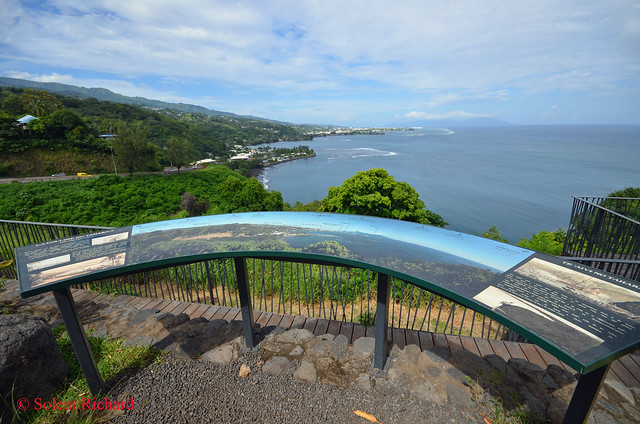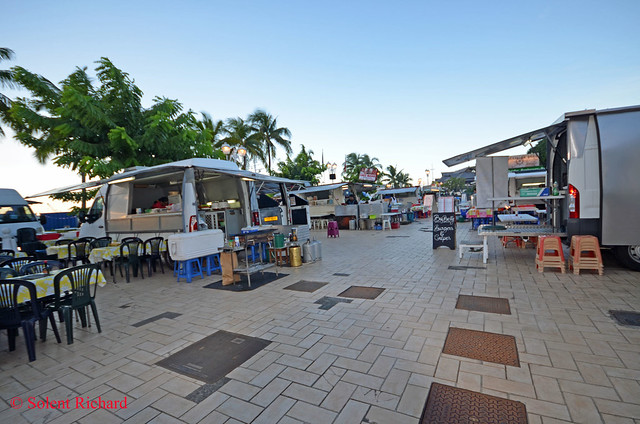Mention the name Tahiti and the ultimate in South Pacific dream islands spring to mind. There is an aura and magnetism in the name that conjures visions in the mind of a tropical paradise, grass skirts, golden beaches and sun.
Hmmm. Not quite the reality. See what you think after this review.
In order to make the most of our day we pre-booked an excursion through a local tour operator…
http://www.tahiti-excursions.com/en/tahiti-tours/60-tour-de-l-ile-de-tahiti.html
Tahiti Excursions offer a 4 and 6 hour version of their island tour. We opted for the full 6 hour version. We did, however, note that there were quite a number of individual tour operators and taxi drivers touting for business at the end of the jetty.
So starting from Pape’ete our guide, Ruth, explained that we would circle the island in a clockwise direction as she explained that the coastal road that circles the island is measured in ‘pointe kilometrique‘ markers, known as PKs. PK0 begins in Pape’ete and markers go in both clockwise and counterclockwise directions, meeting in Taravao, which is PK60 counterclockwise and PK54 clockwise.
Our first stop was in the district of Arue and its famous City Hall, La Saintonge…

Ruth explained its history and how it had become a magnet for painters, photographers and movie makers.
Our next stop was Tahara’a viewpoint…

…which offered a pretty breathtaking 180° view of the island’s North Eastern coast back as far as Pape’ete.
The historical crown jewel of Tahiti is Venus Point and it didn’t take long to get there…

*****

It was here that Ruth took some time to outline both the significance of Point Venus and what we could expect to see on the rest of our journey circumnavigating the island…

In 1769 Captain James Cook arrived in Tahiti on the HMS Endeavour.
He had anchored off Point Venus to record the transit of the planet Venus as it crossed the face of the sun.
The site has great historical significance while it is also one of Tahiti’s favourite beach parks – long black sand beach and good surfing waves.
There are a number of memorials at Point Venus including this one dedicated to The London Missionary Society…

*****

…and this one to the Bounty…

…the rear of which contains the names of the ship’s company of HMS Bounty…

…while not forgetting Captain Cook’s Point venus Memorial…

Considerable time could be spent watching the pack of wild ‘fishing’ dogs going about their business…

…while their human counterparts had obviously taken the day off…

From Point Venus we noticed a change in the coastlines make-up. Though the ‘surfing’ waves remained the black sand made way for an altogether more rugged coastline, lined with volcanic boulders…

This coastline remained till we arrived at the next point on our tour, the Blowhole of Arahoho...

Billed as a major attraction it actually proved a minor disappointment. The original roadway over the blowhole has now collapsed and the effect of the water plume no longer appears as spectacular as past pictures portray.
Tahiti is the largest of the Islands that make up French Polynesia and is also the administrative hub and its hospitals and institutions serve the vast archipelago. Our tour passed one such institution of rather sombre note.
In 1924 the French Administration purchased the Orofara Valley and with the help of protestant ‘deaconesses’ set up a Leper Colony that still survives today, Village Orofara…


At point PK22 we temporarily left the circular coastal road and headed for…

…the Three Waterfalls of Fa’arumai
There are three waterfalls in the valley. The Viamahuta waterfall is 90 m. (295 ft.) high and is easily reached by walking across a bridge and following a well-defined path under a cool canopy of trees…

The two other cascades require a bit of a trek of around 15 minutes along an uneven semi jungle path but are well worth the effort: not just for the final views but the encounters with wild life.

***


Close to the museum and opposite the Botanical gardens we stopped at a local beauty spot for an ‘included’ picnic on the water’s edge…

…before crossing the road to visit the gardens…

Well fed and watered we used some free time to visit the gardens which were extensive and exceptionally well maintained…

*****


Next up after visiting the gardens was another of Pape’ete’s tourist attractions, the Grotto Maraa, a water filled cave where the French painter Paul Gauguin swam. It is now popular with visitors and locals alike…

…the sort of natural wonder that everybody would like to see and stop to admire.
A short distance from The Grotto we arrived at Marae Arahurahu...

Arahurahu is the only marae — an ancient temple or meeting place — in all of Polynesia that has been fully restored and it is maintained like a museum. Although not nearly as impressive as the maraes we visited on Nuku Hiva, this is Tahiti’s best example of ancient Polynesian temples and meeting places, and its exhibit boards do a good job of explaining the significance of each part…

*****

We made one final stop before returning to Pape’ete. Ruth had explained to us the scarcity of running water in the Tahiti homes outside the capital. The mains supply is about 55% efficient and the municipal councils are short of money to make improvements. Many residents refuse to be charged at all for such a “gift from the heavens” and prefer to use natural supplies such as the one that we were about to pass…

That concluded the ‘organised’ part of our Tahiti tour and we were dropped late afternoon back at the capital, Pape’ete, near our ship’s berth on the waterfront park…


*****

…which in turn was not too far from Pape’ete’s Tourist Office…

Armed with tourist map we first stopped at the colourful covered market…

Central to Papeete is the Roman Catholic Notre Dame Cathedral…

Built in 1875 and restored in 1987, this buttercup-yellow church with a red roof and high steeple sits in its own square, a short distance from the market..The altar is always decorated with beautiful tropical flower arrangements and the church fills with light from a dozen stained-glass windows…

The French colonial presence, architecture and influence abound in Papeete, from the magnificent Hôtel de Ville...

…to the Pape’ete Presidency, a recently renovated military barracks…

Tahiti is the economic, cultural and political centre of French Polynesia. No surprise then that it is the home of the French Polynesia Assembly...

*****

…along with the statue of Tahiti’s monument to its most famous politician Pouvana A Oopa…

Other sites worth a visit in Papeete include Bougainville Park…

The Foafai Protestant Temple…

The Koo Men Tong Association Building…

…and its War Memorial and gardens…

It is understood that most cruise ships stay overnight in Papeete, certainly Silver Spirit did. When that is the case the opportunity will therefore arise to enjoy a little piece of local culture at the Hawkers Night Food Market.
We fell upon it as dusk approached and the hawkers were setting up their mobile diners just a stone’s throw from the ship’s berth…

*****

Each to their own of course but it certainly appeared a fun place for supper.
That just about concludes this episode on Tahiti. Certainly for us it did not fully live up to expectations. The capital, Pape’ete certainly didn’t impress: it was consistently grubby and dirty, particularly once away from the waterfront and, of course, there isn’t a great deal to see there either. We got the impression that it’s a very different world outside the large resort hotels which tend to dominate the tourist industry.
We were fortunate in that we booked the excursion we did and to have an excellent guide who was a credit to the company. We would certainly recommend a ‘full day’ round the island tour as there is nothing in Pape’ete to occupy the visitor for more than a pair of hours at the most. On a brighter note they do serve an excellent cider on the waterfront, cheers…

If you have enjoyed this review of Tahiti and would like to be amongst the first to hear of new reviews ( which will soon include Oporto and Cartagena, as well as Monaco) why not join the many other followers by clicking on the ‘Follow’ link on the front page.
You will be alerted by email immediately a new post appears.

Richard … am currently on transatlantic … on the 24 day cruise to Liverpool for Cunard’s 175th. Will you and Barbara be on the ship for that segment? If so, would love to see you guys again. Best, Jan
Good afternoon Jan. Have sent you an email.
Thanks. We are going to Tahiti for the first time next year on a world cruise. As with other ports, I have done some research and this review gives a clear idea of what to see and how to go about it. i will probably look up the firm you recommend. Your other ‘One way to see’ articles are also useful and informative. They either cover where we are going, where we have been and usually echo our own visits and itineraries, or where we hope to go one day.
Wonderful review with stunning photos. Tahiti really is a must for anyone’s bucket list . Can’t wait to visit again. Thanks for your blog Richard. x